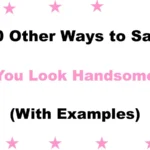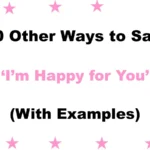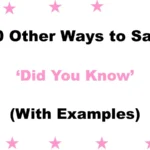Finding the right words to invite someone warmly can transform a routine message into a thoughtful and inviting interaction. While “Please feel free” is polite and clear, exploring 30 alternative phrases helps you match your tone to the context—be it professional, casual, or friendly.
These variations can make your invitations feel more personal, welcoming, and authentic, ensuring your reader understands they truly have permission or encouragement. Whether you’re writing an email, a chat message, or a formal letter, having a diverse vocabulary of invitations at your fingertips makes your communication shine.
What Does “Please Feel Free” Mean?
The phrase “please feel free” is a polite and encouraging way to invite someone to take action without hesitation or worry. It expresses openness and reassurance, letting the other person know they have permission to do something, like asking questions, sharing ideas, or seeking help.
This phrase helps create a welcoming and supportive atmosphere in conversations, whether in personal or professional settings. It’s a simple yet powerful way to show that you value communication and are approachable.
When to Use “Please Feel Free”
You should use “please feel free” when you want to encourage someone to take action without hesitation or worry. It’s perfect for inviting questions, feedback, or requests in conversations, emails, or meetings.
This phrase works well when you want to create a welcoming and open environment, whether in personal or professional contexts. It’s especially helpful when reassuring others that their input or participation is valued and appreciated.
Is It Professional/Polite to Say “Please Feel Free”?
Yes, “please feel free” is generally considered both professional and polite. It conveys respect and openness, encouraging others to communicate without hesitation. This phrase is commonly used in business emails, meetings, and customer interactions to create a friendly yet respectful tone.
However, depending on the context, some may prefer more formal alternatives for highly official settings. Overall, it’s a thoughtful way to show approachability while maintaining professionalism.
Pros and Cons of Using “Please Feel Free”
Pros:
- Universally understood
- Conveys warmth and openness
- Easy to adapt
Cons:
- Can become repetitive
- Occasionally vague without specifics
- Less impactful if overused
Synonyms for “Please Feel Free”
- Don’t hesitate to
- Feel welcome to
- You are welcome to
- By all means
- Be my guest
- Feel at liberty to
- Feel at ease to
- Make yourself at home
- If you’d like to
- At your convenience
- Feel empowered to
- Reach out anytime
- Ask away
- Contact me anytime
- Share your thoughts
- Explore as you wish
- Comment freely
- Suggest anything
- Propose ideas
- Express yourself
- Contribute when ready
- Join in whenever
- Select whatever works
- Browse at will
- Don’t think twice about
- There’s no harm in
- You have full permission to
- It’s open to you to
- You’re at liberty to
- The choice is yours to
1. Don’t Hesitate To
Definition: Invites someone to act without reluctance.
Detailed Explanation: This phrase emphasizes overcoming uncertainty, reassuring the person that their action is welcome.
Scenario Examples: After offering help on a project, you say, “Don’t hesitate to ask for more resources.”
Best Use: Encouraging questions or requests.
Worst Use: When the recipient may feel imposed upon.
Tone: Supportive, reassuring, and open
2. Feel Welcome To
Definition: Conveys a warm invitation to participate or use something.
Detailed Explanation: “Feel welcome to” adds a friendly, hospitable nuance, often used in casual or semi-formal contexts.
Scenario Examples: “Feel welcome to join our brainstorming session tomorrow.”
Best Use: Team meetings, social gatherings.
Worst Use: Highly formal corporate communications.
Tone: Friendly, inclusive, and inviting
3. You Are Welcome To
Definition: Grants permission politely and formally.
Detailed Explanation: This clear alternative suits emails, official letters, and presentations.
Scenario Examples: “You are welcome to review the draft at your leisure.”
Best Use: Formal requests and offers.
Worst Use: Informal chats where it may sound stiff.
Tone: Polite, formal, and respectful
4. By All Means
Definition: Strong encouragement to proceed.
Detailed Explanation: An idiomatic expression that enthusiastically gives permission.
Scenario Examples: “By all means, schedule the meeting at a time that works for you.”
Best Use: Confident, decisive contexts.
Worst Use: When overused—it can feel bossy.
Tone: Encouraging, confident, and assertive
5. Be My Guest
Definition: A casual, friendly way to offer permission.
Detailed Explanation: Conveys a laid-back, informal invitation, as if hosting someone.
Scenario Examples: “Be my guest—take any seat you like.”
Best Use: Informal or social situations.
Worst Use: Formal business communications.
Tone: Casual, welcoming, and warm
6. Feel at Liberty To
Definition: Grants permission in a slightly formal manner.
Detailed Explanation: Adds nuance of freedom and autonomy for the recipient.
Scenario Examples: “Feel at liberty to adjust the draft as necessary.”
Best Use: Semi-formal professional emails.
Worst Use:/Text messages—sounds too formal for texting.
Tone: Formal, respectful, and empowering
7. Feel at Ease To
Definition: Encourages action without discomfort.
Detailed Explanation: Emphasizes the recipient’s comfort and confidence.
Scenario Examples: “Feel at ease to share any concerns you have.”
Best Use: Sensitive or personal discussions.
Worst Use: Direct commands—can soften urgency too much.
Tone: Gentle, comforting, and empathetic
8. Make Yourself at Home
Definition: A very warm, hospitable invitation.
Detailed Explanation: Borrowed from hospitality, it conveys full comfort and ease.
Scenario Examples: “Please, make yourself at home in the office lounge.”
Best Use: In-person visits or coworking spaces.
Worst Use: Formal written correspondence.
Tone: Warm, hospitable, and friendly
9. If You’d Like To
Definition: Offers optional permission.
Detailed Explanation: Softens the invitation, making it entirely optional.
Scenario Examples: “If you’d like to add feedback, feel free to comment below.”
Best Use: Surveys, feedback requests.
Worst Use: When a stronger invitation is needed.
Tone: Casual, optional, and polite
10. At Your Convenience
Definition: Invites action on the recipient’s schedule.
Detailed Explanation: Shows respect for their time and priorities.
Scenario Examples: “Please review the proposal at your convenience.”
Best Use: Formal requests with flexible deadlines.
Worst Use: Urgent matters—too relaxed.
Tone: Respectful, formal, and considerate
11. Feel Empowered To
Definition: Encourages action with a sense of authority.
Detailed Explanation: Motivates the recipient by emphasizing their agency.
Scenario Examples: “You’re part of the team—feel empowered to make decisions.”
Best Use: Leadership and mentorship contexts.
Worst Use: Overwhelming recipients who lack confidence.
Tone: Motivational, empowering, and supportive
12. Reach Out Anytime
Definition: Opens the door for ongoing communication.
Detailed Explanation: Signals that the speaker is always available to help.
Scenario Examples: “Have questions? Reach out anytime.”
Best Use: Customer support, mentoring.
Worst Use: When you genuinely cannot be always available.
Tone: Open, accessible, and friendly
13. Ask Away
Definition: An informal, enthusiastic invitation to ask questions.
Detailed Explanation: Conveys eagerness to help and answer queries.
Scenario Examples: “Curious about the process? Ask away!”
Best Use: Q&A sessions, informal presentations.
Worst Use: Formal reports—too casual.
Tone: Enthusiastic, casual, and responsive
14. Contact Me Anytime
Definition: Offers availability around the clock.
Detailed Explanation: Promises consistent accessibility for the recipient.
Scenario Examples: “Need assistance? Contact me anytime.”
Best Use: Service roles, urgent support.
Worst Use: When boundaries are needed.
Tone: Dependable, available, and courteous
15. Share Your Thoughts
Definition: Invites opinions and feedback.
Detailed Explanation: Encourages active participation and dialogue.
Scenario Examples: “We value your input—share your thoughts below.”
Best Use: Feedback requests, team meetings.
Worst Use: When direction is needed rather than feedback.
Tone: Collaborative, open, and inclusive
16. Explore as You Wish
Definition: Grants freedom to investigate or browse.
Detailed Explanation: Ideal for guiding someone through resources or options.
Scenario Examples: “Here’s our library—explore as you wish.”
Best Use: Product tours, resource libraries.
Worst Use: When specific guidance is required.
Tone: Informal, exploratory, and relaxed
17. Comment Freely
Definition: Encourages open online discussion.
Detailed Explanation: Invites uncensored feedback or opinions.
Scenario Examples: “Your voice matters—comment freely below.”
Best Use: Blog posts, social media.
Worst Use: Formal reports—too casual.
Tone: Casual, interactive, and engaging
18. Suggest Anything
Definition: Opens floor to any idea or proposal.
Detailed Explanation: Conveys genuine interest in creative input.
Scenario Examples: “Our next event is yours—suggest anything.”
Best Use: Brainstorming, ideation sessions.
Worst Use: When suggestions need to be scoped.
Tone: Creative, open-minded, and inviting
19. Propose Ideas
Definition: Invites formal idea submissions.
Detailed Explanation: Suitable for structured innovation processes.
Scenario Examples: “Propose ideas for our next campaign.”
Best Use: Workshops, strategic meetings.
Worst Use: Casual chats—sounds too formal.
Tone: Professional, structured, and collaborative
20. Express Yourself
Definition: Encourages personal, authentic input.
Detailed Explanation: Highlights emotional or creative expression.
Scenario Examples: “This journal is yours—express yourself freely.”
Best Use: Creative writing, team culture-building.
Worst Use: Data-driven or technical contexts.
Tone: Encouraging, personal, and creative
21. Contribute When Ready
Definition: Allows participation at the recipient’s pace.
Detailed Explanation: Respects individual timelines and readiness.
Scenario Examples: “Our open doc is live—contribute when ready.”
Best Use: Collaborative documents, open-source projects.
Worst Use: Projects with strict deadlines.
Tone: Respectful, flexible, and inclusive
22. Join In Whenever
Definition: Invites participation at any point.
Detailed Explanation: Ideal for ongoing events or discussions.
Scenario Examples: “Our chat is open 24/7—join in whenever.”
Best Use: Online forums, live streams.
Worst Use: Time-bound meetings.
Tone: Casual, open, and welcoming
23. Select Whatever Works
Definition: Empowers choice among options.
Detailed Explanation: Useful when multiple options are available.
Scenario Examples: “Here are three templates—select whatever works for you.”
Best Use: Resource sharing, toolkits.
Worst Use: When a specific choice is required.
Tone: Empowering, flexible, and helpful
24. Browse at Will
Definition: Grants freedom to look through materials.
Detailed Explanation: Conveys a casual invitation to explore.
Scenario Examples: “Our gallery is open—browse at will.”
Best Use: Online catalogs, libraries.
Worst Use: When guidance is necessary.
Tone: Relaxed, informal, and inviting
25. Don’t Think Twice About
Definition: Encourages decisive action without overthinking.
Detailed Explanation: Reassures the person that their choice is supported.
Scenario Examples: “Don’t think twice about reaching out if you need help.”
Best Use: Quick decisions, urgent support.
Worst Use: Complex decisions requiring deliberation.
Tone: Encouraging, direct, and supportive
26. There’s No Harm In
Definition: Softens the invitation by minimizing risk.
Detailed Explanation: Suggests the action is low-stakes and worth trying.
Scenario Examples: “There’s no harm in giving the new tool a test run.”
Best Use: Trials, experiments, first-time actions.
Worst Use: High-risk situations.
Tone: Reassuring, casual, and low-pressure
27. You Have Full Permission To
Definition: Formally grants rights or authority.
Detailed Explanation: Leaves no ambiguity about consent.
Scenario Examples: “You have full permission to modify the document.”
Best Use: Legal or compliance contexts.
Worst Use: Casual settings—may sound heavy.
Tone: Formal, authoritative, and clear
28. It’s Open to You To
Definition: Suggests an available opportunity.
Detailed Explanation: Emphasizes the recipient’s choice and freedom.
Scenario Examples: “It’s open to you to choose your working hours.”
Best Use: Flexible policies, voluntary programs.
Worst Use: Rigid processes.
Tone: Respectful, open, and neutral
29. You’re at Liberty To
Definition: Grants freedom in a formal tone.
Detailed Explanation: Conveys legal or official permission.
Scenario Examples: “You’re at liberty to inspect the premises.”
Best Use: Official permissions, legal contexts.
Worst Use: Informal conversations.
Tone: Formal, precise, and respectful
30. The Choice Is Yours To
Definition: Highlights the recipient’s control over the decision.
Detailed Explanation: Encourages autonomy and personal preference.
Scenario Examples: “The choice is yours to attend or skip the workshop.”
Best Use: Situations offering multiple paths.
Worst Use: When guidance or recommendation is needed.
Tone: Empowering, neutral, and supportive
Conclusion
Choosing the right words to say please feel free can truly elevate your communication, making it more thoughtful, warm, and personal. Whether you’re inviting someone to ask questions, offering assistance, or simply encouraging openness, these 30 alternatives give you a rich palette to express yourself with care and professionalism.
Each phrase has its own unique tone and best-use scenarios, so you can tailor your message perfectly to fit any context—be it casual, formal, or somewhere in between. Remember, the key to meaningful communication lies not just in what you say, but how you say it. Using these thoughtful expressions helps foster connection, respect, and genuine kindness in every conversation.
FAQs
1. What does “please feel free” really mean?
It is a polite and inviting way to encourage someone to take an action without hesitation or worry, like asking questions or expressing their thoughts.
2. When is it appropriate to say “please feel free”?
It’s best used when you want to show openness, offer help, or encourage someone to act comfortably, especially in emails, meetings, or casual conversations.
3. Are there professional alternatives to “please feel free”?
Yes! Alternatives like “you’re welcome to”, “don’t hesitate to”, or “please don’t hesitate” are often preferred in formal or business settings.
4. Can “please feel free” sound too informal?
In some very formal or official communications, it may seem a bit casual. Choosing alternatives with a more formal tone can be better suited.
5. How can I choose the best alternative?
Consider the tone of your relationship, the context, and your audience. Use warmer phrases for personal messages and more formal ones for professional interactions.

Mia Rose is a passionate Language Coach and Contributor at GrammarPeaks, where she specializes in practical grammar tips and language learning strategies. With a strong foundation in education and communication, Mia brings a friendly, approachable style to her writing. Her goal is to make complex grammar rules simple and usable for learners at any level, helping them grow in both confidence and fluency.





